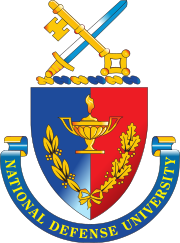
The National War College (NWC) of the United States is a school in the National Defense University. It is housed in Roosevelt Hall on Fort Lesley J. McNair, Washington, D.C., the third-oldest Army post still active.

The Naval War College is the staff college and "Home of Thought" for the United States Navy at Naval Station Newport in Newport, Rhode Island. The NWC educates and develops leaders, supports defining the future Navy and associated roles and missions, supports combat readiness, and strengthens global maritime partnerships.

James Rodney Schlesinger was an American economist and public servant who was best known for serving as Secretary of Defense from 1973 to 1975 under Presidents Richard Nixon and Gerald Ford. Prior to becoming Secretary of Defense, he served as Chair of the Atomic Energy Commission (AEC) from 1971 to 1973, and as CIA Director for a few months in 1973. He became America's first Secretary of Energy under Jimmy Carter in 1977, serving until 1979.

Nathan Farragut Twining was a United States Air Force general. He was the chief of Staff of the United States Air Force from 1953 until 1957, and the third chairman of the Joint Chiefs of Staff from 1957 to 1960. He was the first member of the Air Force to serve as Chairman. Twining was a distinguished "mustang" officer, rising from private to four-star general and appointment to the highest post in the United States Armed Forces in the course of his 45-year career.

The Single Integrated Operational Plan (SIOP) was the United States' general plan for nuclear war from 1961 to 2003. The SIOP gave the President of the United States a range of targeting options, and described launch procedures and target sets against which nuclear weapons would be launched. The plan integrated the capabilities of the nuclear triad of strategic bombers, land-based intercontinental ballistic missiles (ICBM), and sea-based submarine-launched ballistic missiles (SLBM). The SIOP was a highly classified document, and was one of the most secret and sensitive issues in U.S. national security policy.

Ashton Baldwin Carter was an American government official and academic who served as the 25th United States secretary of defense from February 2015 to January 2017. He later served as director of the Belfer Center for Science & International Affairs at Harvard Kennedy School.

Robert G. Joseph is a senior scholar at the National Institute for Public Policy. He was the United States Special Envoy for Nuclear Nonproliferation, with ambassadorial rank. Prior to this post, Joseph was the Under Secretary of State for Arms Control and International Security, a position he held until January 24, 2007. Joseph is known for being instrumental in creating the Proliferation Security Initiative and as the architect of the Global Initiative to Combat Nuclear Terrorism. He was also the US chief negotiator to Libya in 2003 who convinced the Libyans to give up their WMD programs. He also recently authored a book describing his experience in negotiating with Libya entitled "Countering WMD."

Andrew Jackson Goodpaster was an American Army General. He served as NATO's Supreme Allied Commander, Europe (SACEUR), from July 1, 1969, and Commander in Chief of the United States European Command (CINCEUR) from May 5, 1969, until his retirement December 17, 1974. As such, he was the commander of all NATO (SACEUR) and United States (CINCEUR) military forces stationed in Europe and the surrounding regions.
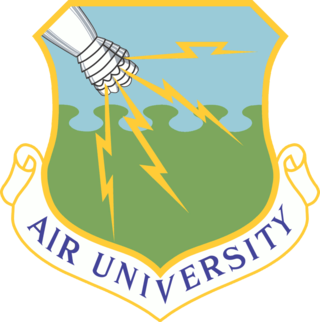
Air University is a professional military education university system of the United States Air Force. It is accredited by the Commission on Colleges of the Southern Association of Colleges and Schools to award master's degrees.

The Joint Forces Staff College (JFSC), located in Norfolk, Virginia, was established as the Armed Forces Staff College in 1946 and incorporated into the National Defense University in August 1981. It educates and acculturates joint and multinational warfighters to plan and lead at the operational level. Military operations increasingly require the Armed Services to work jointly, and JFSC provides students the tools to operate in a joint environment. JFSC is composed of three schools, each with different student populations and purposes.

The Air War College (AWC) is the senior Professional Military Education (PME) school of the U.S. Air Force. A part of the United States Air Force's Air University, AWC emphasizes the employment of air, space, and cyberspace in joint operations. Headquartered at Maxwell Air Force Base in Montgomery, Alabama, its higher headquarters is the Air Education and Training Command (AETC) at Randolph Air Force Base in San Antonio, Texas. It is one of six war colleges within the U.S. Department of Defense's Joint Professional Military Education (JPME) Phase II Education Program for commissioned officers.

The Dwight D. Eisenhower School for National Security and Resource Strategy, formerly known as the Industrial College of the Armed Forces (ICAF), is a part of the National Defense University. It was renamed on September 6, 2012, in honor of Dwight D. Eisenhower who graduated from this school when it was previously known as the Army Industrial College.

The National Defence University (NDU), formerly introduced as Army War Course (1963–70), the National Defence College (1970–2007), is the military university with additional status of public university of the Islamic Republic of Pakistan focused on military education and training for the armed forces, including Pakistan military forces and two hundred foreign participants. Formerly established on 28 May 1970 at Rawalpindi, its academic principles are focused on command instructions, national security, military strategy, and war studies among other specified academic disciplines. It is one of the oldest military education and training institutes in the country with additional enrollments reserved for the civil servants.
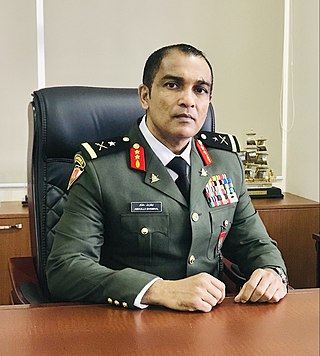
Lieutenant General (retd) Abdulla Shamaal MA MSc ndu psc is the former Chief of Defence Force (CDF) of Maldives National Defence Force (MNDF). General Shamaal was appointed to the post of Chief of Defence Force on 11 December 2018 by President Ibrahim Mohamed Solih and served until 17 November 2023. Shamaal was trained in various military institutions such as the United States Army Infantry School in Fort Benning, the Pakistan Military Academy and the Defence Services Staff College in India. Shamaal was previously discharged from service in November 2013 but was reinstated in December 2018 following High Court verdict that his discharge was unlawful. He has also held various Senior Command, Staff and Instructional appointments during his career.

Richard L. Kugler is an American thinker and writer on U.S. national security policy and defense strategy.

Joint Professional Military Education (JPME) is a form of Professional Military Education (PME) in the United States that emphasizes a multiservice approach. Joint Professional Military Education was established following greater awareness during World War II of a need for effective cooperation between the branches of the United States armed forces. While some institutions had previously served to provide joint training, notably the Army and Navy Staff College that operated in the last years of the War, the first senior school for Joint Professional Military Education was founded in 1946 under the direction of the Chairman of the Joint Chiefs of Staff. The 1986 passage of the Goldwater–Nichols Act caused increased interest in Joint Professional Military Education and created a standard. As of 2005, JPME contains five levels, successful completion of two of which are among the qualifications for the designation Joint Service Officer. Joint Professional Military Education levels are available at a number of colleges and JPME Institutions.

Clarence Steven McGann was an American diplomat who served as the United States Ambassador to Fiji, Kiribati, Nauru, Tonga, and Tuvalu from 2008 to 2011. He was nominated by President George W. Bush, and assumed his duties at post in October 2008.

Paul Joseph Selva is a retired United States Air Force general who served as the tenth vice chairman of the Joint Chiefs of Staff. In this capacity, he was the nation's second-highest-ranking military officer, and the highest-ranking officer in the Air Force. He assumed his last assignment on July 31, 2015, and retired on August 1, 2019. Selva is a command pilot with more than 3,100 hours in the C-5, C-17A, C-141B, C-37, KC-10, KC-135A and T-37.
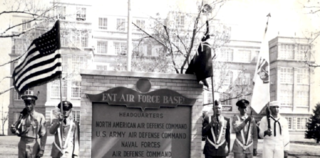
Continental Air Defense Command (CONAD) was a Unified Combatant Command of the United States Department of Defense, tasked with air defense for the Continental United States. It comprised Army, Air Force, and Navy components. It included Army Project Nike missiles anti-aircraft defenses and USAF interceptors. The primary purpose of continental air defense during the CONAD period was to provide sufficient attack warning of a Soviet bomber air raid to ensure Strategic Air Command could launch a counterattack without being destroyed. CONAD controlled nuclear air defense weapons such as the 10 kiloton W-40 nuclear warhead on the CIM-10B BOMARC. The command was disestablished in 1975, and Aerospace Defense Command became the major U.S. component of North American Air Defense Command (NORAD).
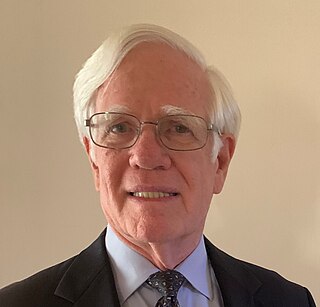
Linton Wells II is an American public servant and educator who served a total of 51 years in government service. He served 26 years in the United States Navy as an officer, and then was appointed by the President of the United States as the Principal Deputy Assistant Secretary of Defense, serving through two administrations of both parties, both the Democrat Bill Clinton and the Republican George W. Bush. He wrote many books, articles, and white papers on matters of national security, including important texts related to the use of American military capabilities in global humanitarian operations. His expertise focused on the strategic impacts of technological change and on building resilience to natural and man-made disasters as issues of US national security. He shaped, over five decades of public service, current US Department of Defense directives that link policy and technology with public-private cooperation. His writings significantly altered U.S. and international approaches to civil-military engagement, US policy in global humanitarian assistance, and global public-private partnerships in disaster relief. He has also made fundamental contributions to technical areas that have defined network-enabled military capabilities and cyberspace operations. After retiring from public service, he continued to contribute to the international STAR-TIDES network that he had founded in 2007, a consortium of several thousand global nodes comprising agencies, organizations, institutions and individuals in 40+ countries that promote the free exchange of research results on global issues of human security. As of 2021 he is Executive Advisor to the Center for Resilient and Sustainable Communities (C-RASC) at George Mason University and chairs the Advisory Group of the C4I and Cyber Center there. C-RASC has been working with the People-Centered Internet (PCI) on ways to “put humanity at the center of the Internet” and support a variety of revitalization initiatives. He is on the board of PCI, and also the President and CEO of Global Resilience Strategies and Senior Advisor to Resilient Japan. He was listed by Fortune magazine in 2009 as one of the top 16 "Players of Tech".
